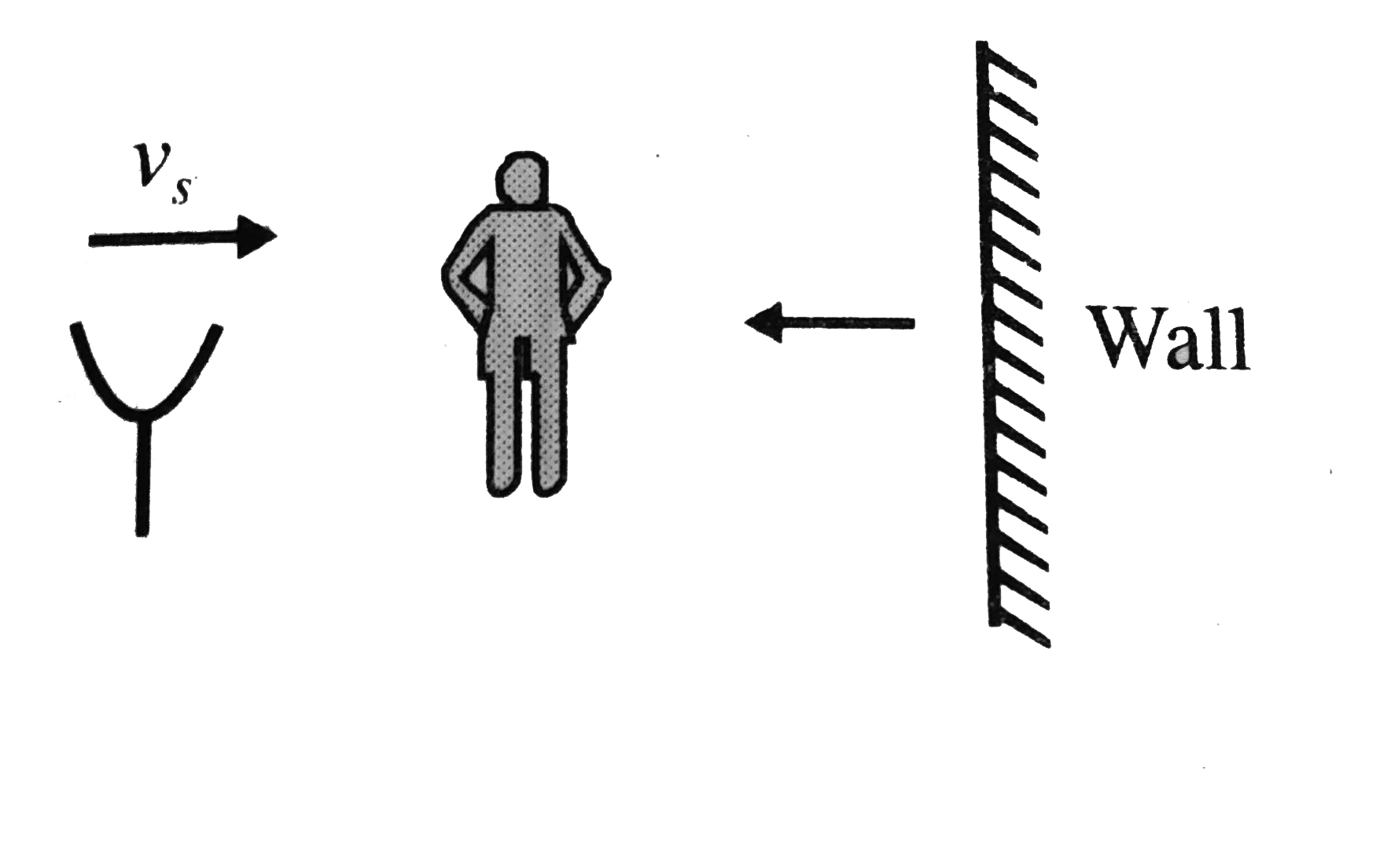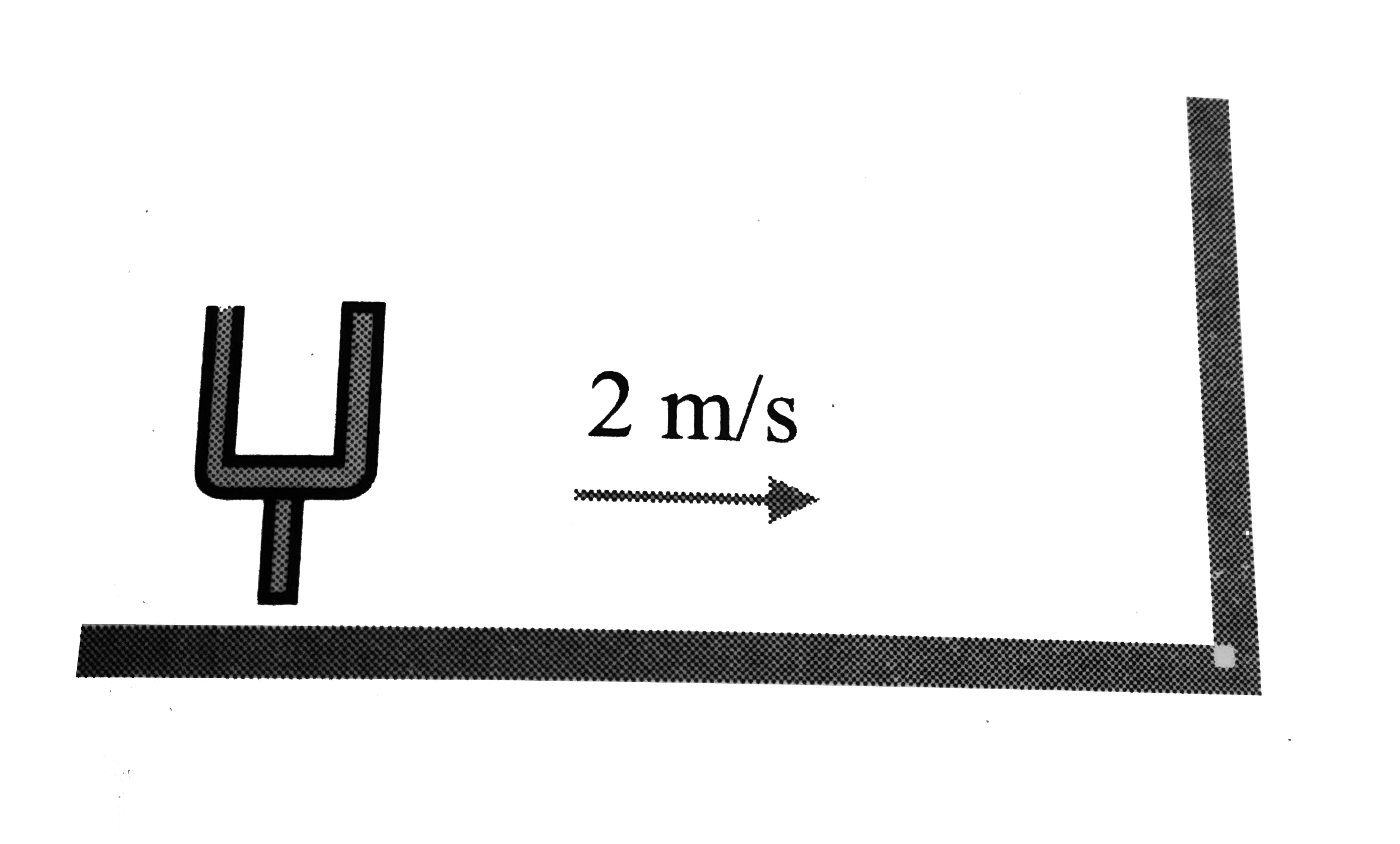A tuning fork of frequency 328Hz is moved towards a wall at a speed of 2ms−1. An observer standing on the same side as the fork hears two sounds, one directly from the fork and the other reflected from the wall. Number of beats per second is (Velocity of sound in air 330ms−1).
4
5
6
7
The correct Answer is:A
To solve the problem, we need to determine the frequencies of the sounds heard by the observer: one directly from the tuning fork and the other reflected from the wall. We will then find the number of beats per second between these two frequencies.
Step 1: Determine the frequency heard directly from the tuning fork
The frequency of the tuning fork is given as f0=328Hz. Since the observer is stationary and the source (tuning fork) is moving towards the observer, we can use the Doppler effect formula for a source moving towards a stationary observer:
f′=f0v+vov−vs
Where:
- f′ = frequency heard by the observer
- f0 = frequency of the source (328 Hz)
- v = speed of sound in air (330 m/s)
- vo = speed of the observer (0 m/s, since the observer is stationary)
- vs = speed of the source (2 m/s)
Substituting the values:
f′=328Hz⋅330+0330−2=328⋅330328=330Hz
Step 2: Determine the frequency of the sound reflected from the wall
When the sound reflects off the wall, the wall acts as a stationary source. The frequency heard by the observer from the reflected sound can be calculated using the Doppler effect formula again, but this time the source is the wall (which is stationary) and the observer is moving towards it. The frequency of the sound reflected back to the observer is given by:
f′′=f′v+vov−vs
Where:
- f′′ = frequency of the reflected sound
- f′ = frequency heard from the tuning fork (330 Hz)
- vo = speed of the observer (0 m/s)
- vs = speed of the source (2 m/s)
Substituting the values:
f′′=330Hz⋅330+0330−2=330⋅330328=332Hz
Step 3: Calculate the number of beats per second
The number of beats per second is given by the absolute difference between the two frequencies:
Number of beats=|f′′−f′|=|332Hz−330Hz|=2Hz
Final Answer
The number of beats per second is 2Hz.
The frequency of the tuning fork is given as f0=328Hz. Since the observer is stationary and the source (tuning fork) is moving towards the observer, we can use the Doppler effect formula for a source moving towards a stationary observer:
- f′ = frequency heard by the observer
- f0 = frequency of the source (328 Hz)
- v = speed of sound in air (330 m/s)
- vo = speed of the observer (0 m/s, since the observer is stationary)
- vs = speed of the source (2 m/s)
When the sound reflects off the wall, the wall acts as a stationary source. The frequency heard by the observer from the reflected sound can be calculated using the Doppler effect formula again, but this time the source is the wall (which is stationary) and the observer is moving towards it. The frequency of the sound reflected back to the observer is given by:
- f′′ = frequency of the reflected sound
- f′ = frequency heard from the tuning fork (330 Hz)
- vo = speed of the observer (0 m/s)
- vs = speed of the source (2 m/s)
The number of beats per second is given by the absolute difference between the two frequencies:
The number of beats per second is 2Hz.
Topper's Solved these Questions
- WAVESBook:NARAYNAChapter:WAVESExercise:Exercise-I (H.W)
Explore 101 Videos
- WAVESBook:NARAYNAChapter:WAVESExercise:Exercise-II (C.W)
Explore 15 Videos
- WAVESBook:NARAYNAChapter:WAVESExercise:C.U.Q
Explore 68 Videos
- VECTORSBook:NARAYNAChapter:VECTORSExercise:LEVEL-II (H.W)
Explore 14 Videos
- WORK , ENERGY & POWER Book:NARAYNAChapter:WORK , ENERGY & POWER Exercise:EXERCISE IV
Explore 43 Videos
Similar Questions
A tuning fork of frequency 90Hz is sounded and moved towards an observer with a speed equal to one - tenth the speed of sound. The note heard by the observer will have a frequency
View Solution
A tuning fork of frequency 380 Hz is moving towards a wall with a velocity of 4ms Then the number of beats heard by a stationary listener between direct and reflected sound will be (velocity of sound in air is 340ms)
View Solution
Knowledge Check
A car emitting sound of frequency 500 Hz speeds towards a fixed wall at 4ms. An observer in the car hears both the source frequency as well as the frequency of sound reflected from the wall. If he hears 10 beats per second between the two sounds, the velocity of sound in air will be
A330msB387msC404msD340msA man is running with a fork of frequency 340 Hz towards a huge wall with a velocity 2m/s, then the number of beats heard per second is (Velocity of sound in air is 342 m/s)
A2B6C4D8
As shown if Fig. a vibrating tuning fork of frequency 512 Hz is moving towards the wall with a speed 2ms. Take speed of sound as v=340ms and answer the following questions.
Q. Suppose that a listener is located at rest between the tuning fork and the wall. Number of beats heard by the listener per second will beA4B3C0D1
A siren emitting a sound of frequency 800 Hz moves away from an observer towards a cliff at a speed of 15ms−1. Then the frequency of sound that the observer hears in the echo reflected from the cliff is (Take velocity of sound in air =330ms−1)
View SolutionA siren emitting a sound of frequency 800 Hz moves away from an observer towards a cliff at a speed of 15ms−1. Then the frequency of sound that the observer hears in the echo reflected from the cliff is (Take velocity of sound in air =330ms−1)
View SolutionA source of sound of frequency 165 Hz generates sound waves which get fully reflected from a wall . A person standing at the wall starts moving away from the wall. The minimum distance of the point from the wall at which the person hears maximum sound is (velocity of sound = 330 ms−1)
View SolutionA siren emitting a sound of frequency 800 Hz moves away from an observer towards a cliff at a speed of 15ms−1. Then the frequency of sound that the observer hears in the echo reflected from the cliff is (Take velocity of sound in air =330ms−1)
View SolutionWhen a tuning fork of frequency 341 is sounded with another tuning fork, six beats per second are heard. When the second tuning fork is loaded with wax and sounded with the first fork, the number of beats is two per second. The natural frequency of the second tuning fork is
View Solution

